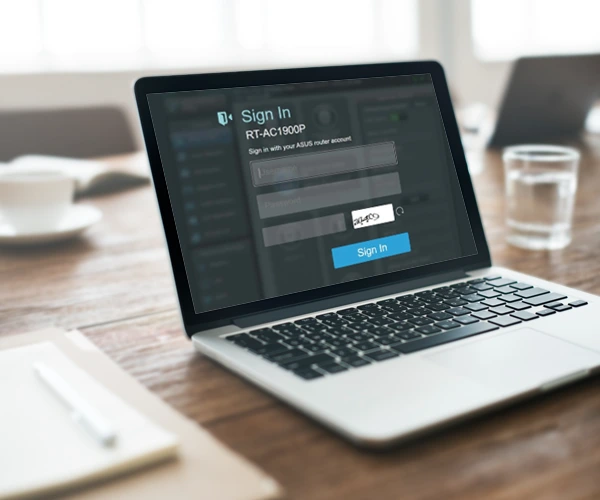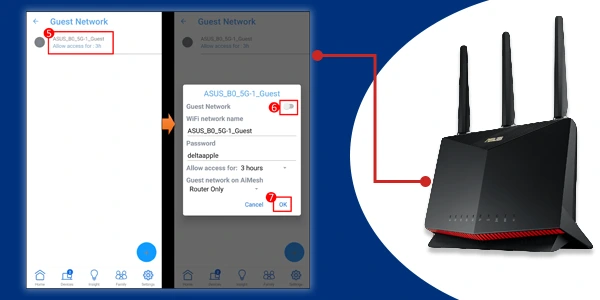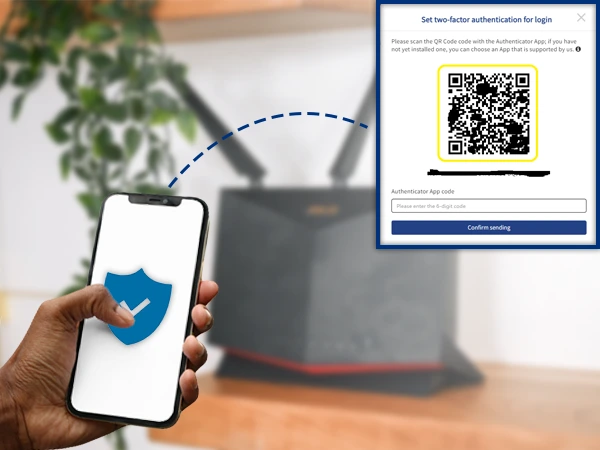ASUS Router Login: Easily Access, Configure, and Manage Your Network
Welcome to your go-to resource for managing and logging into your ASUS router. This thorough site will assist you in safely and swiftly logging into your ASUS router, whether you’re setting up a new router, changing your Wi-Fi password, or resolving connection problems.
Although ASUS routers are known for their dependability, speed, and cutting-edge capabilities, the first step to gaining complete control over your network is knowing how to access the ASUS router login page. Everything from firmware updates and security settings to router.asus.com login is covered in this tutorial.
What is the login page for the ASUS router?
Your Wi-Fi network’s control center is the ASUS router login page. With its web-based interface, you can:
- Set up your password and Wi-Fi name (SSID).
- Keep an eye on devices that are linked.
- Update the firmware.
- Control guest networks and parental restrictions.
- Modify firewalls and security settings.
- In the URL bar of your browser, you may usually type router.asus.com, asus.router.login, or 192.168.1.1 to reach the site.

The Step-by-Step Guide to ASUS Router Login
The following easy steps will help you log in to your ASUS router:
- Verify that your computer, tablet, or smartphone is linked to your ASUS router via a LAN cable or Wi-Fi.
- Launch the online browser of your choice, such as Chrome, Safari, Edge, or Firefox.
Enter any of the ensuing in the address bar:
- router.asus.com
- Asus.router.login,
- router.asus.login,
- and asus.router.login
- or 192.168.0.1 or 192.168.1.1 as an IP address
You will be sent to the ASUS router login screen after pressing Enter.
- Enter your username and password when prompted.
- Admin is the default username.
- Admin is the default password, or the one listed on the router label.
- Use your most recent login information if you have previously changed it.
- You can configure all network settings on your router’s administration dashboard after logging in.
Why to maintain ASUS Router Login?
You may completely configure and safeguard your home network by logging into your ASUS router. Once inside, you can accomplish the following:
- Modify the Wi-Fi password and SSID.
- Create guest networks for guests.
- Update the firmware to improve security and performance.
- Track linked devices in real time.
- Turn on parental controls to control access to the internet.
- Increase bandwidth for streaming or gaming.
- Set up a VPN for privacy.
You can maintain the security and efficiency of your network by frequently visiting the login page for your ASUS router.
Login to the ASUS Router App (Mobile Access)
Without opening a browser, you can manage your network from any location with the ASUS Router App.
To Begin:
- Get the ASUS Router app.
- Link your phone to the network of your router.
- Open the app and sign in with your ASUS account or admin identifications.
- You can monitor connected devices, access all router features, and even remotely reset the router.
- The app offers immediate alerts for firmware upgrades or intrusions and syncs directly with router.asus.com.
First-Time ASUS Router Configuration
Before signing in, take these steps to configure your recently purchased ASUS router:
- Unpack your router and use the WAN port to connect it to the modem.
- Turn on router and plug in power adapter.
- Join the ASUS Wi-Fi network by default on your computer or mobile device (the SSID often begins with “ASUS_”).
- Go to router asus login in your browser.
- Create a new admin username and password by following the on-screen setup wizard.
- Personalize your Wi-Fi password and name.
- After doing this, you will be sent to the ASUS router dashboard, where you may control your network.
Management of Mesh Network Logins and Guest Access
Multiple login levels and network administration features are available on modern ASUS routers, particularly the ZenWiFi series.

Configuring the Guest Network:
- Go to router.asus.com and log in.
- Visit the Guest Network.
- Set a temporary password and enable it.
- Select access restrictions or time limitations.
Management of Mesh Networks:
When utilizing an ASUS AiMesh system:
- Go to your main router and log in.
- Go to Nodes in AiMesh.
- View or modify mesh nodes that are connected.
- From a single, central login, control every network parameter.
Integration of ASUS Accounts and Remote Login
Using your ASUS account, you may remotely access ASUS routers. With the ASUS Router App or online interface, you can access your router from any location.
How It Operates:
- Use the online interface to create an ASUS account.
- In the settings, turn on Remote Access Mode.
- Use the smartphone app or my.asus.com to log in remotely.
- When managing several routers or monitoring your home network while on the road, this is extremely helpful.
Best Practices for ASUS Router Security Login
Keep your network safe by taking these crucial precautions:
- Change the ASUS router’s default login information right away.
- Turn on Wi-Fi encryption using WPA3.
- Disable remote login unless absolutely necessary.
- Using the ASUS app, enable two-factor authentication (2FA).
- Update the firmware.
- To remove the cache, set up automatic reboots once a week.
- Regularly check linked devices for unauthorized access.
Login to ASUS Routers for Gaming and Business Networks
Additional functions are obtainable in the login portal of an ASUS ROG Rapture or ASUS Pro router:
For gamers:
- Use Game Boost or QoS to give gaming traffic priority.
- For smooth multiplayer connectivity, use Open NAT.
- Set up VPN Fusion to play games safely.
For Companies:
- Oversee many SSIDs for staff and visitor access.
- For network segmentation, use VLAN.
- Track each device’s bandwidth use.
- Provide remote workers with secure VPN tunnels.
Solving ASUS Router Login Problems
Users occasionally encounter problems logging in to asus.router.login or router.asus.com. The following are typical issues and their fixes:
If the router page for the ASUS login doesn’t load:
- Make sure your device is linked to the LAN or ASUS Wi-Fi network.
- Instead of entering router.asus.com, try typing 192.168.1.1.
- Try a dissimilar browser or remove the cache in your current one.
- Restart your device and router and do asus router login in.
If incorrect credentials cause the login to fail:
- Verify the password and username again (case-sensitive).
- Check the sticker of the router for the default credentials.
- Reset router to factory settings if you can’t remember it (push and hold the reset key for 10 to 15 seconds).
If your internet isn’t functioning after logging in:
- Verify the security of the modem connection.
- In the admin panel, check the WAN settings.
- From the Administration > Firmware Upgrade menu, update the firmware.
ASUS Router Firmware Update
Updating the firmware on a regular basis is necessary to preserve performance and security.
Methods for Updating:
- Go to router.asus.com and log in to your ASUS router.
- Select Administration > Upgrade Firmware.
- Click “Check Update.”
- The most recent firmware will mechanically obtained and install.
- Having the most recent bug fixes, new features, and improved stability is ensured by updating the firmware.
Restoring the Default Configurations on Your ASUS Router
Resetting your router may be helpful if you are having trouble logging in or if you have forgotten your ASUS login credentials.
- Trace the Reset knob, which is often on the back, to reset.
- To get the power light to flash, press and hold the knob.
- Await the reboot of the router.
- Re-enter router.asus.com using the default login information.
- You will need to adjust your Wi-Fi settings after a restart.
Protecting Your Login to the ASUS Router
Your router serves as the entryway to your online life, so keeping it safe is essential.
Use these pointers to improve security:
- Immediately change the ASUS router’s default login password.
- Validate that your WiFi keyword is sturdy and consists of a amalgamation of letters, numbers, and symbols.
- If not in use, turn off remote access.
Update the firmware
- Keep an eye on linked devices on a regular basis.
- You may prevent unwanted access to your router.asus.login panel by adhering to these.

Changing Network Configuration After Logging in
You may adjust your network to suit your needs after logging in:
Wi-Fi Configuration
- Modify 2.4GHz and 5GHz networks, switch SSIDs, or conceal your network from the general public.
Network of Guests
- Give guests temporary access without disclosing your primary password.
Controls by Parents
- Schedule children’s internet access or block particular websites
Quality of Service, or QoS
- Set bandwidth priorities for work, gaming, and streaming apps.
Setting Up a VPN
- To access the internet securely, set up a VPN client or server.
- The ASUS login router dashboard is where you can control all of them.
Supported ASUS Router Models
All of the main models of ASUS routers are covered by the login instructions, including:
- RT-AX86U, RT-AX88U, and RT-AX55 ASUS
- ZenWiFi AX from ASUS (XT8, XD6, ET12)
- ASUS ROG Rapture GT-AX11000 and GT-AXE16000 ASUS RT-AC68U, RT-AC86U, and RT-AC5300
- Routers from ASUS Blue Cave and TUF Gaming
What Happens If router.asus.com Isn’t Functional?
- If neither routerlogin.asus nor router.asus.com loads:
- Directly try the IP address 192.168.1.1.
- Temporarily turn off your proxy or VPN.
- Make sure the LAN cable is connected to your router correctly.
- Try using a different device to access.
- Reset your router or get in touch with support if the problem continues.
Login to the ASUS Router from Various Devices
Although the login procedure is essentially the same on all devices, for convenience, below is a breakdown:
Sign in using Mac or Windows.
- Attach a LAN or Wi-Fi wire to your router.
- Get your browser open.
- Enter 192.168.1.1 or router.asus.com.
- To access your admin panel, enter your credentials.
- On Android, log in
- Link your Android smartphone to your ASUS wireless network.
- Launch Chrome.
Login to router.asus.
- Put in your administrator credentials.
- Access your iPhone or iPad.
- Join the ASUS Wi-Fi network.
- Type asus.router.login into Safari.
- Enter your login information.
- Use the ASUS Router App (available on iOS and Android) for an even more convenient mobile experience.
The key to complete control over your home or business network is logging into your ASUS router. The procedure is designed to be upfront yet actual, regardless of whether you use router.asus.com, router.asus.login, or asus.router.login.
By frequently visiting your ASUS router’s login page, you can make sure your Wi-Fi is safe, up to date, and operating at its best. Now that you have this guide, you can confidently control every function, upgrade firmware, and handle login difficulties from a single dashboard.
FAQs
What is the correct address to access the ASUS router login page?
To access the router’s login interface, enter router.asus.com or IP addresses 192.168.1.1 or 192.168.0.1 in the browser when connected to the ASUS network.
I forgot my ASUS login router password. How can I regain access?
Holding down the reset knob will cause the power light to flicker for 10 to 15 seconds. By doing this, you can use the default my asus login credentials that are printed on the router to return to the factory settings.
Why does my browser show a "Page Not Found" or connection error when using router.asus.com or 192.168.1.1?
Make sure your device is LAN or Wi-Fi connected to the router, turn off a VPN or proxy, empty the cache on your browser, and try again with IP 192.168.1.1 in place of the hostname.
Can I use the ASUS Router App to log in and manage settings?
Indeed. Download the ASUS Router App from Google Play or the App Store, connect to your network, then login into ASUS router or admin credentials to adjust settings simply.
Is it safe to keep my ASUS router login page exposed to the internet?
No, turn off remote access when it’s not required. To stop unwanted external access to your router, use strong passwords, turn on two-factor authentication, and enable WPA3 encryption.
What is ASUSWRT?
The web-based ASUSWRT interface, which is integrated into ASUS routers, enables users to upgrade firmware, monitor devices, control security, and modify network settings all from a single dashboard.
What should I do after my first successful login?
For extra protection, modify the default administrator credentials, create a special Wi-Fi name and password, turn on automatic firmware upgrades, and set up guest networks or parental controls.
